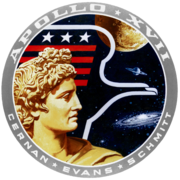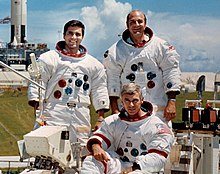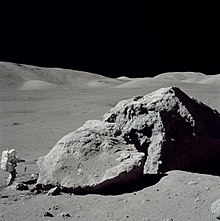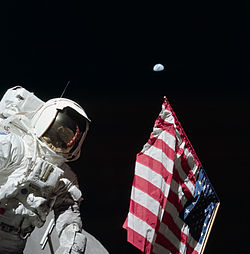| Revision as of 20:37, 15 November 2008 view sourceDonaldd23 (talk | contribs)Extended confirmed users49,082 editsm Removed duplicate info. This esact information is already in a separate section below.← Previous edit | Revision as of 10:11, 21 November 2008 view source Lightmouse (talk | contribs)Pending changes reviewers148,333 edits Date audit per mosnum/overlink/Other using AWBNext edit → | ||
| Line 10: | Line 10: | ||
| |booster = ] SA-512 | |booster = ] SA-512 | ||
| |launch_pad = ]<br/>{{nowrap|]}}<br/>], ] | |launch_pad = ]<br/>{{nowrap|]}}<br/>], ] | ||
| |launch_date = |
|launch_date = December 7, 1972<br/>05:33:00 ] | ||
| |lunar_landing = |
|lunar_landing = December 11, 1972{{spaces|3}}02:23:35 UTC<br/>]<br/>20° 11' 26.88" N{{spaces|3}}30° 46' 18.05" E<br/>(based on the ]<br/>Mean Earth Polar Axis ]) | ||
| |lunar_eva_duration = First{{pad|1.95em}}07:11:53<br/>Second{{spaces|3}}07:36:56<br/><!-- | |lunar_eva_duration = First{{pad|1.95em}}07:11:53<br/>Second{{spaces|3}}07:36:56<br/><!-- | ||
| -->Third{{pad|1.65em}}07:15:08<br/>Total{{pad|1.7em}}22:03:57 | -->Third{{pad|1.65em}}07:15:08<br/>Total{{pad|1.7em}}22:03:57 | ||
| Line 19: | Line 19: | ||
| |lunar_sample_mass = 110.52 kg (243.65 lb) | |lunar_sample_mass = 110.52 kg (243.65 lb) | ||
| |time_lunar_orbits = 6 d 03 h 43 m 37 s | |time_lunar_orbits = 6 d 03 h 43 m 37 s | ||
| |landing = |
|landing = December 19, 1972<br/>19:24:59 UTC<br/>{{coord|17|53|S|166|7|W|type:landmark_globe:moon}} | ||
| |mission_duration = 12 d 13 h 51 m 59 s | |mission_duration = 12 d 13 h 51 m 59 s | ||
| |crew_photo = Apollo 17 crew.jpg | |crew_photo = Apollo 17 crew.jpg | ||
| Line 27: | Line 27: | ||
| }} | }} | ||
| '''Apollo 17''' was the eleventh ] in the ] ]. It was the first night launch of a ] ] and the sixth and final lunar landing mission of the Apollo program. The mission was launched on |
'''Apollo 17''' was the eleventh ] in the ] ]. It was the first night launch of a ] ] and the sixth and final lunar landing mission of the Apollo program. The mission was launched on December 7, 1972, and concluded on December 19. As of 2008, it remains the most recent manned ]. | ||
| == Crew == | == Crew == | ||
| Line 76: | Line 76: | ||
| === Docking === | === Docking === | ||
| * '''Undocked''': |
* '''Undocked''': December 11, 1972 - 17:20:56 UTC | ||
| * '''Docked''': |
* '''Docked''': December 15, 1972 - 01:10:15 UTC | ||
| === EVAs === | === EVAs === | ||
| ] rocket.]] | ] rocket.]] | ||
| * '''''Cernan and Schmitt''''' - EVA 1 | * '''''Cernan and Schmitt''''' - EVA 1 | ||
| ** '''EVA 1 Start''': |
** '''EVA 1 Start''': December 11, 1972, 23:54:49 ] | ||
| ** '''EVA 1 End''': |
** '''EVA 1 End''': December 12 07:06:42 UTC | ||
| ** '''Duration''': 7 hours, 11 minutes, 53 seconds | ** '''Duration''': 7 hours, 11 minutes, 53 seconds | ||
| * '''''Cernan and Schmitt''''' - EVA 2 | * '''''Cernan and Schmitt''''' - EVA 2 | ||
| ** '''EVA 2 Start''': |
** '''EVA 2 Start''': December 12, 1972, 23:28:06 UTC | ||
| ** '''EVA 2 End''': |
** '''EVA 2 End''': December 13 07:05:02 UTC | ||
| ** '''Duration''': 7 hours, 36 minutes, 56 seconds | ** '''Duration''': 7 hours, 36 minutes, 56 seconds | ||
| * '''''Cernan and Schmitt''''' - EVA 3 | * '''''Cernan and Schmitt''''' - EVA 3 | ||
| ** '''EVA 3 Start''': |
** '''EVA 3 Start''': December 13, 1972, 22:25:48 UTC | ||
| ** '''EVA 3 End''': |
** '''EVA 3 End''': December 14 05:40:56 UTC | ||
| ** '''Duration''': 7 hours, 15 minutes, 08 seconds | ** '''Duration''': 7 hours, 15 minutes, 08 seconds | ||
| * ''''' Evans ''''' (''Schmitt'' - Stand up) - Transearth EVA 4 | * ''''' Evans ''''' (''Schmitt'' - Stand up) - Transearth EVA 4 | ||
| ** '''EVA 4 Start''': |
** '''EVA 4 Start''': December 17, 1972, 20:27:40 UTC | ||
| ** '''EVA 4 End''': |
** '''EVA 4 End''': December 17 21:33:24 UTC | ||
| ** '''Duration''': 1 hour, 05 minutes, 44 seconds | ** '''Duration''': 1 hour, 05 minutes, 44 seconds | ||
| Line 146: | Line 146: | ||
| "As I take man's last step from the surface, back home for some time to come — but we believe not too long into the future — I'd like to just what I believe history will record — that America's challenge of today has forged man's destiny of tomorrow. And, as we leave the Moon at Taurus-Littrow, we leave as we came and, God willing, as we shall return, with peace and hope for all mankind. Godspeed the crew of Apollo 17." | "As I take man's last step from the surface, back home for some time to come — but we believe not too long into the future — I'd like to just what I believe history will record — that America's challenge of today has forged man's destiny of tomorrow. And, as we leave the Moon at Taurus-Littrow, we leave as we came and, God willing, as we shall return, with peace and hope for all mankind. Godspeed the crew of Apollo 17." | ||
| : – Eugene A. Cernan, Apollo 17 Commander. Last man to walk on the moon, |
: – Eugene A. Cernan, Apollo 17 Commander. Last man to walk on the moon, December 14, 1972. | ||
| == Mission insignia == | == Mission insignia == | ||
Revision as of 10:11, 21 November 2008
| COSPAR ID | 1972-096A |
|---|---|
| SATCAT no. | 06300 |
| Mission duration | 12 d 13 h 51 m 59 s |
| Start of mission | |
| Launch date | December 7, 1972 05:33:00 UTC |

 ← ← | |
Apollo 17 was the eleventh manned space mission in the NASA Apollo program. It was the first night launch of a U.S. human spaceflight and the sixth and final lunar landing mission of the Apollo program. The mission was launched on December 7, 1972, and concluded on December 19. As of 2008, it remains the most recent manned Moon landing.
Crew
Number in brackets indicates number of spaceflights by each individual prior to and including this mission.
- Eugene A. Cernan (3) - Commander
- Ronald E. Evans (1) - Command Module Pilot
- Harrison H. Schmitt (1) - Lunar Module Pilot
Joe Engle was the originally selected as the LMP, but once it became clear that Apollo 17 would be the last lunar flight, the scientific community pressed NASA to select a scientist-astronaut to land on the Moon. This led to Schmitt, a trained geologist, being removed from the crew of the now cancelled Apollo 18 and replacing Engle on 17.
Backup crew
- John W. Young - Commander
- Stuart A. Roosa - Command Module Pilot
- Charles M. Duke, Jr - Lunar Module Pilot
The original backup crew for this mission was the Apollo 15 prime crew:
- David R. Scott - Commander
- Alfred M. Worden - Command Module Pilot
- James B. Irwin - Lunar Module Pilot
The Apollo 15 prime crew received the backup assignment since this was to be the last lunar mission and the backup crew would not rotate to another mission. However, when the Apollo 15 postage stamp incident became public in early 1972 the crew was reprimanded by NASA and the Air Force (they were active duty officers). Director of Flight Crew Operations Deke Slayton removed them from flight status and replaced them with Young and Duke from the Apollo 16 prime crew and Roosa from the Apollo 14 prime and Apollo 16 backup crews.
Support Crew
Mission parameters
- Mass:
- Launch mass: 6,455,000 lb (2,923,400 kg)
- Total spacecraft: 102,900 lb (46,700 kg)
- CSM mass: 66,840 lb (30,320 kg), of which CM was 13,140 lb (5960 kg), SM 53,700 lb (24,360 kg)
- LM mass: transposition and docking stage 36,274 lb (16,454 kg), separation for lunar landing 36,771 lb (16,679 kg), ascent stage at liftoff 10,997 lb (4,988 kg)
- Earth orbits: 2 before leaving for Moon, approximately one on return
- Lunar orbits: 75
- Perigee: 104.9 mi (168.9 km)
- Apogee: 106.4 mi (171.3 km)
- Inclination: 28.526°
- Period: 87.83 min
- Perilune: 60.5 mi (97.4 km)
- Apolune: 195.6 mi (314.8 km)
- Inclination: 159.9°
- Period: ~120 min
- Landing Site: 20.19080° N - 30.77168° E or
20° 11' 26.88" N - 30.1° 46' 18.05" E
Docking
- Undocked: December 11, 1972 - 17:20:56 UTC
- Docked: December 15, 1972 - 01:10:15 UTC
EVAs
- Cernan and Schmitt - EVA 1
- EVA 1 Start: December 11, 1972, 23:54:49 UTC
- EVA 1 End: December 12 07:06:42 UTC
- Duration: 7 hours, 11 minutes, 53 seconds
- Cernan and Schmitt - EVA 2
- EVA 2 Start: December 12, 1972, 23:28:06 UTC
- EVA 2 End: December 13 07:05:02 UTC
- Duration: 7 hours, 36 minutes, 56 seconds
- Cernan and Schmitt - EVA 3
- EVA 3 Start: December 13, 1972, 22:25:48 UTC
- EVA 3 End: December 14 05:40:56 UTC
- Duration: 7 hours, 15 minutes, 08 seconds
- Evans (Schmitt - Stand up) - Transearth EVA 4
- EVA 4 Start: December 17, 1972, 20:27:40 UTC
- EVA 4 End: December 17 21:33:24 UTC
- Duration: 1 hour, 05 minutes, 44 seconds
The splashdown point was 17° 52′ S, 166° 7′ W, 350 nautical miles (650 km) SE of the Samoan Islands and 6.5 km (4 mi) from the recovery ship USS Ticonderoga. Apollo 17 landed approximately 640 meters from its target point.
Mission highlights
| This section needs expansion. You can help by making an edit requestadding to it . (June 2007) |





Template:FixBunching One of the last two men to set foot on the Moon was also the first scientist-astronaut, geologist Harrison ("Jack") Schmitt. While Evans circled in America, Schmitt and Cernan collected a record 109 kg (240 pounds) of rocks during three Moonwalks. The crew roamed for 34 km (21 miles) through the Taurus-Littrow valley in their rover, discovered orange-colored soil, and left the most comprehensive set of instruments in the ALSEP on the lunar surface. Their mission was the last in the Apollo lunar landing missions. The last 4 Apollo crafts were used for the three Skylab missions and the ASTP, mission in 1975.
Introduction
Crew members were Eugene Cernan, commander; Ron Evans, command module pilot; and Harrison Schmitt, lunar module pilot.
The landing site for this mission was on the southeastern rim of the Mare Serenitatis, in the southwestern Montes Taurus. This was a dark mantle between three high, steep massifs, in an area known as the Taurus-Littrow region. Pre-mission photographs showed boulders deposited along the bases of the mountains, which could provide bedrock samples. The area also contained a landslide, several impact craters, and some dark craters which could be volcanic.
A J-class mission, featuring the Lunar Rover, they conducted three lunar surface excursions, lasting 7.2, 7.6 and 7.3 hours. The mission returned 110.5 kg (243.6 lb) of samples from the Moon.
On this mission the astronauts took a famous photograph of the earth known as "The Blue Marble", which shows the almost the entire continent of Africa and the continent of Antartica. The other lunar landing missions that photographed the earth shortly after lunar orbit insertion showed the western hemisphere.
Mission notes

- Schmitt, a geologist, was the first (and to date, only) scientist to walk on the Moon.
- Like the astronauts of Apollo 10, 12, 13, and 14 before them, the Apollo 17 crew were recovered in Pacific waters near American Samoa after splashdown, and were flown from the recovery ship to the airport at Tafuna where they were greeted with an enthusiastic (and well practiced) Samoan reception before being flown on to Honolulu, thence to Houston.
- The plaque left on the ladder of the descent stage of Challenger read: Here Man completed his first explorations of the moon. December 1972 AD. May the spirit of peace in which we came be reflected in the lives of all mankind. The plaque showed two hemispheres of Earth and the near side of the Moon, plus the signatures of Cernan, Evans, Schmitt, and President Nixon.
- Commander Eugene Cernan took a Czechoslovak flag with him to the Moon because his ancestors came from Czechoslovakia. Later he gave it to the Institute of astronomy in Ondrejov (Czech Republic).
- Schmitt was originally due to fly on the cancelled Apollo 18 but following pressure from the science community was moved up to LM pilot on Apollo 17 in place of Joe Engle.
- Apollo 17 broke several records set by previous flights, including longest manned lunar landing flight; longest total lunar surface extravehicular activities; largest lunar sample return, and longest time in lunar orbit.
- Apollo 17 was the last manned NASA mission to land on the moon. The next crewed NASA mission to land on the Moon is very tentatively scheduled to occur in 2019 with Orion 15 mission.
Quotes
"Ah! You see one Earth, you've seen them all."
- – Jack Schmitt, Lunar Module Pilot.
"As I take man's last step from the surface, back home for some time to come — but we believe not too long into the future — I'd like to just what I believe history will record — that America's challenge of today has forged man's destiny of tomorrow. And, as we leave the Moon at Taurus-Littrow, we leave as we came and, God willing, as we shall return, with peace and hope for all mankind. Godspeed the crew of Apollo 17."
- – Eugene A. Cernan, Apollo 17 Commander. Last man to walk on the moon, December 14, 1972.
Mission insignia
The circular patch is one of the most detailed of the Apollo series. The official NASA press release said: "The insignia is dominated by the image of Apollo, the Greek sun god. Suspended in space behind the head of Apollo is an American eagle of contemporary design, the red bars of the eagle's wing represent the bars in the U.S. flag; the three white stars symbolize the three astronaut crewmen. The background is deep blue space and within it are the Moon, the planet Saturn and a spiral galaxy or nebula. The Moon is partially overlaid by the eagle's wing suggesting that this is a celestial body that man has visited and in that sense conquered. The thrust of the eagle and the gaze of Apollo to the right and toward Saturn and the galaxy is meant to imply that man's goals in space will someday include the planets and perhaps the stars. The colors of the emblem are red, white and blue, the colors of the U.S. flag; with the addition of gold, to symbolize the golden age of space flight that will begin with this Apollo 17 lunar landing. The Apollo image used in this emblem was the Apollo of Belvedere sculpture now in the Vatican Gallery in Rome. This emblem was designed by artist Robert T. McCall in collaboration with the astronauts." The insignia is surrounded by a light gray band with names of the crew and the words APOLLO XVII.
Capsule locations
The Command Module America is currently on display at Space Center Houston in Houston, Texas.
The Lunar Module Challenger impacted the Moon December 15, 1972 at 06:50:20.8 UT (1:50 AM EST) 19.96 N, 30.50 E.
Media
- Astronaut Harrison Schmitt falls while on a moonwalk
- Harrison Schmitt sings I was strolling on the Moon one day
- Apollo 17's Lunar Module blasts off and leaves the moon
Depiction in fiction
Portions of the Apollo 17 mission are dramatized in the miniseries From the Earth to the Moon episode entitled "Le Voyage dans la Lune".
Additionally, there have been fictional astronauts in film, literature and television who have been described as "the last man to walk on the moon," implying they were crew members on Apollo 17. One such character was Steve Austin in the television series The Six Million Dollar Man. In the 1972 novel Cyborg, upon which the series was based, Austin remembers watching the Earth "fall away during Apollo XVII." In an episode of the series, Austin clearly states that he flew on "Apollo 17". Another example is the character of Captain Tanner in the science fiction film Deep Impact.
The mission patch for Apollo 17 was used for the mission patch for the NASA space ship Charybdis in an episode of "Star Trek: The Next Generation" entitled "The Royale".
In WALL-E, the main characters flying away from Earth pass the Moon and the landing site of Apollo 17 (or perhaps one of the other "J" missions: Apollo 15 and 16). Behind the landing site one sees a large sign on the lunar surface exclaiming the future site of a shopping mall.
See also
- Extra-vehicular activity
- Google Moon
- List of artificial objects on the Moon
- List of spacewalks
- Splashdown
References
- Richard W. Orloff. "Apollo by the Numbers: A Statistical Reference (SP-4029)". NASA.
- Donald K. Slayton, "Deke!" (New York: Forge, 1994), 279
- Portfolio from Apollo - TIME
- Caidin, Martin: Cyborg, page 15. Warner Paperback Library, 1972.
- NASA NSSDC Master Catalog
- Apollo 17 Info by NASA
- Apollo by the numbers: A Statistical Reference by Richard W. Orloff (NASA)
- Development of Manned Space Flight, American and Soviet NASA SP-4209
- The Apollo Spacecraft: A Chronology
- Apollo Program Summary Report
- Apollo 17 Characteristics - SP-4012 NASA historical data book
- Apollo 17 entry at Apollo Lunar Surface Journal - Provides an extensive insight of the mission, along with full transcripts and detailed interviews with the crewmembers.
- Lattimer, Dick (1985). 'All We Did was Fly to the Moon. Whispering Eagle Press. ISBN 0-9611228-0-3.
External links
- Apollo 17 - entry in Encyclopedia Astronautica
- Apollo 17 - Final Reflections on Apollo Video as the crew wraps up the final Apollo mission
- Apollo 17 - Science Experiments
- Apollo 17 - Voice Transcript Pertaining to the Geology of the Landing Site
- Apollo landing Locations at Google Moon
- Apollo Lunar Surface VR Panoramas QTVR panoramas
- Apollo simulation for Orbiter spaceflight sim
- September 1973 National Geographic Magazine article
- Transcript of lifting off from the Moon
- Apollo 17 television transmissions ApolloTV.net Video
| Apollo program | |||||||||||
|---|---|---|---|---|---|---|---|---|---|---|---|
| Launch complexes |  | ||||||||||
| Ground facilities | |||||||||||
| Launch vehicles | |||||||||||
| Spacecraft and rover | |||||||||||
| Flights |
| ||||||||||
| Apollo 8 specific | |||||||||||
| Apollo 11 specific | |||||||||||
| Apollo 12 specific | |||||||||||
| Apollo 13 specific | |||||||||||
| Apollo 14 specific | |||||||||||
| Apollo 15 specific | |||||||||||
| Apollo 16 specific | |||||||||||
| Apollo 17 specific | |||||||||||
| Post-Apollo capsule use | |||||||||||
| Related | |||||||||||
| |||||||||||